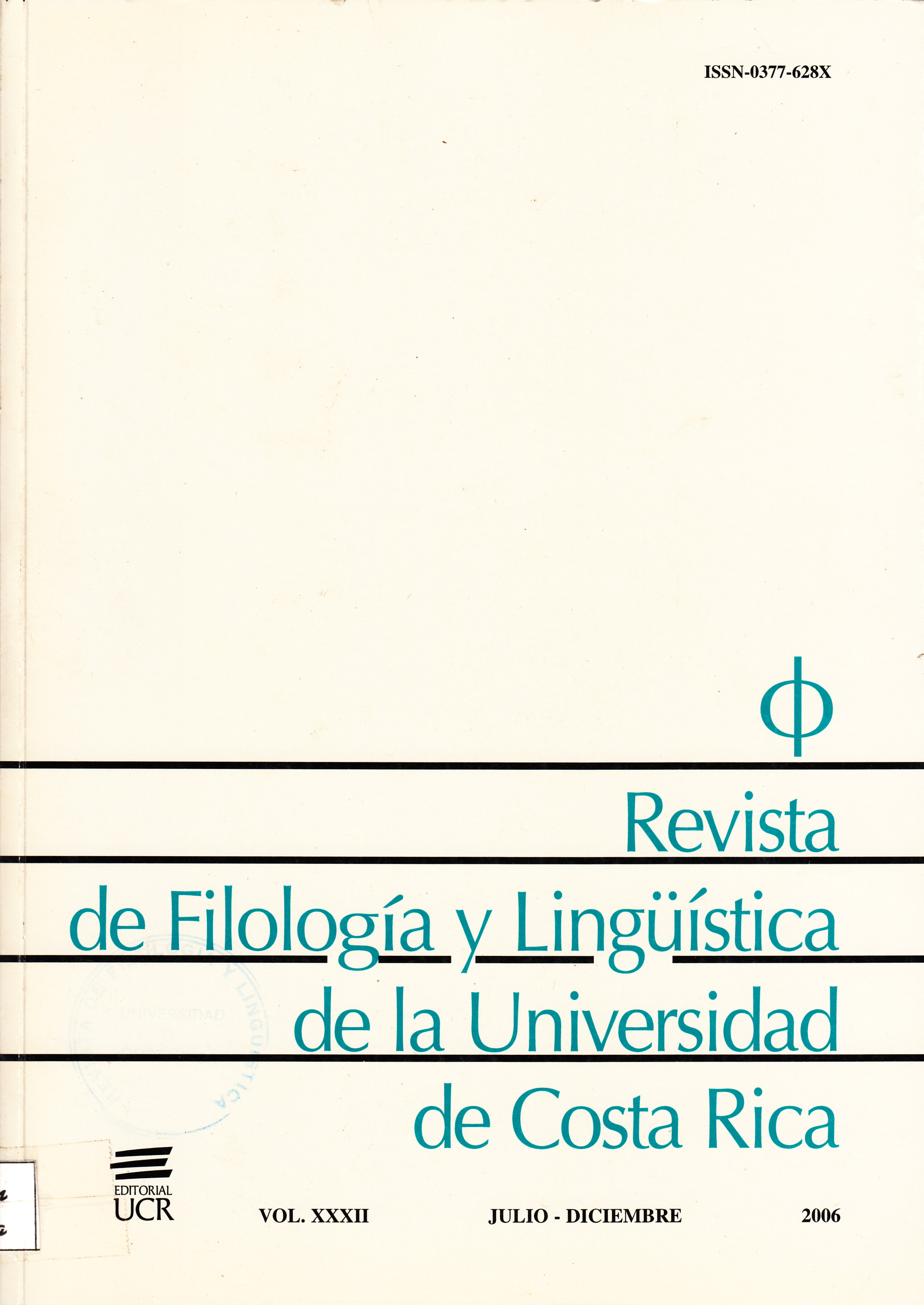Abstract
The analysis of the Spanish data produced by speakers from the Costa Rican Central Valley evidenced that the trill has been substituted by an assibilated rhotic, while the tap also undergoes assibilation in three contexts: 1) in complex /tr/ onset clusters, 2) word-medially in complex onsets that come after a voiced coronal /l/ or /n/, and 3) in /rC/ clusters where the rhotic is in coda position, always before one or more bound clitic morphemes. Additionally, the tap assibilates phrase-finally. The proposal is that the assibilation of the trill results from the cross-linguistic tendency to reduce the articulation process: instead of producing the trill which requires controlled, precise, and sustained movement of the tongue tip, the magnitude of the movement of the tongue tip is reduced, resulting in assibilation of the trill in all contexts. Assibilation of the tap is explained in terms of coarticulation.References
Agüero, A. 1962. El español de América y Costa Rica. 2n ed. San José: Lehman.
Argüello, F. 1978. The žeista dialect of Spanish spoken in Ecuador: A phonetic and phonological study. Ph.D. dissertation, Pennsylvania State University.
Berk-Seligson, S. 1984. Subject reactions to phonological varation in Costa Rican Spanish. Journal of Psycholinguistic Research. 13: 415- 442.
Bonnet, E. & J. Mascaró. 1997. On the representation of contrasting rhotics. In: A. Morales- Front and F. Martínez-Gil (eds.). Issues in phonology and morphology of the major Iberian languages, 103-126. Washington D.C.: Georgetown University Press.
Bradley, T.G. 1998. Assibilation in Ecuadorian Spanish. In J.M. Authier, B.E. Bullock, and L.A. Reed (eds.) Formal Perspectives on Romance Linguistics. Selected papers from the 28th Linguistic Symposium on Romance Languages, April, 1998, 57- 71.
(1999). Assibilation in Ecuadorian Spanish: A phonology-phonetics account. Formal Perspectives on Romance Linguistics. J. M. Authier, B.E. Bullock, and L. A. Reed (Eds.), 57-71. Amsterdam: John Benjamins.
(2002). (To appear). Gestural timing and rhotic variation in Spanish Codas. Laboratory Approaches to Spanish Phonology, ed. by Timothy Face. Berlin: Mouton de Gruyter.
(2005). Systemic markedness and phonetic detail in phonology. In Experimental an theoretical approaches to romance linguistics, ed. By Randal Gess and ed Rubin, 41-62. Amsterdam: John Benjamins.
Bradley, T.G. & B. Schmeiser. 2001. On the phonetic reality of Spanish / in complex onsets. University of California: Working draft.
Browman C. & L. Goldstein. 1986. Towards and articulatory phonology. Phonology Yearbook. 3: 219- 252.
Calvo Shadid, A. & M. Portilla Chaves. 1998. Variantes retroflejas de y en el habla culta de San José. Revista Káñina. 22 (1): 81- 86.
Canfield, D. L. 1962. La Pronunciación del Español en América. Bogotá: Grupo Caro y Cuervo XVII.
(1981). Spanish pronunciation in the Americas. Chicago: The University of Chicago Press.
Cárdenas, D. 1958. The geographic distribution of assibilated R and RR in Spanish America. Orbis. 7: 407- 410.
Chavarría Aguilar, O. 1951. The phonemes of Costa Rican Spanish. Language. 27: 248- 253.
Cotton, E. & J. Sharp. 1988. Spanish in the Americas. Washington D.C. George University Press.
Cuéllar, B. 1971. Observaciones sobre la “RR” velar y “Y” africada en Cuba. Español Actual. 20: 18- 20.
Gaínza, G. 1976. El español de Costa Rica: Breve consideración acerca de su estudio. Revista de Filología y Lingüística. 11 (4): 79- 84.
Harris, J.W. 1969. Spanish Phonology. Cambridge, Massachusetts: MIT Press.
(1983). Syllable structure and stress in Spanish. Cambridge, Massachusetts: MIT Press.
Jiménez, B. 1967. Acquisition of Spanish consonants in children aged 3-5;7 months. Language and speech Hearing Service Schools. 18: 357- 363.
Kenstowicz, M. 1994. Phonology in generative grammar. Cambridge, MA: Blackwell Publishers.
Ladefoged, P. 2001. A course in phonetics. University of California, Los Angeles: Harcourt College Publishers.
Lipski, J.M. 1994. Latin American Spanish. New York: Longman.
(1990). Spanish taps and trills: Phonological structure of an isolated opposition. Folia Lingüística. 29: 153- 174.
Menéndez Pidal, R. 1964. Orígenes del español. 5th ed. Madrid, España: Espasa-Calpe.
Navarro, T. 1974. El español de Puerto Rico. Universidad de Puerto Rico: Editorial Universitaria.
Núñez, R. 1980. La fonología moderna y el español de Santo Domingo. Santo Domingo, República Dominicana: Editora Taller.
Ohalla, J.J. 1995. Phonetic explanantions for sound patterns: Implications for grammars of competence. University of California, Berkeley.
Phillips R. 1967. Los Angeles Spanish: A descriptive análisis. Unpublished Doctoral Dissertation, University of Wisconsin.
Quilis, A. 1999. Tratado de fonología y fonética españolas. Madrid: Editorial Gredos.
Recasens, D. 1991. On the production characteristics of apicoalveolar taps and trills. Journal of phonetics. 19: 267- 280.
Sánchez Corrales, V. 1986. Escisión fonológica de en el español de Costa Rica. Revista de Filología y Lingüística. 12 (2): 129- 133.
Stockwel, R.P. & Bowen, J.D. 1965. The sounds of English and Spanish. Chicago: The University of Chicago Press.
Umaña Aguilar, J. 1981. Variable vibrants in middle-class Costa Rican Spanish. Unpublished Masters Thesis, Georgetown University.
Widdison, K. 1998. Phonetic motivation in Spanish trills. Orbis: bulletin international de documentation linguistique. 140: 51- 61.

